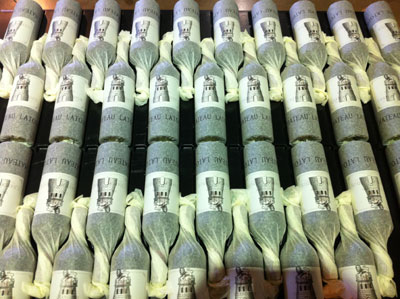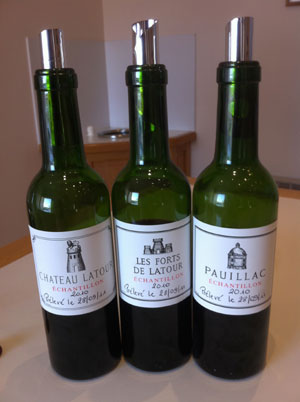There are a lot of wine writers who write about wine seriously but there are very few serious writers who write about wine. In the UK we have, for example, Andrew Jefford who is a brilliant writer as well as happening to know his stuff when it comes to wine (and beer). In the USA Jay McInerney writes a wine column in the Wall Street Journal and has recently published “The Juice” which is now available in the UK (Bloomsbury, £14.99). McInerney is one of America’s best novelists and his most famous work “Bright Lights, Big City” was cited by Time Magazine as one of the nine generation-defining novels of the twentieth century. By kind permission of the author here is a brief extract from “The Juice” – a book that I would thoroughly recommend to all wine lovers. Stephen Browett
“A Towering Red: Château Latour” by Jay McInerney.
When Frédéric Engerer was a university student in Paris, he would drive once a month to Burgundy. "For a young man in his 20s, Burgundy was less intimidating," he told me recently, "and you can get appointments more easily." Bordeaux, with its grand chateaux and wealthy absentee owners, is much more formal and daunting. The first time that Mr. Engerer ever set foot on the hallowed ground of Bordeaux first growth Château Latour was after François Pinault offered him the job of managing the estate. "Latour had always been a mystical estate for me, but I honestly didn't dare ask for an appointment at Latour in those days," Mr. Engerer said.

Frédéric Engerer
|
The hiring of Mr. Engerer to run one of the world's most fabled domains caused almost as much comment as Mr. Pinault's purchase of the property in 1993. Mr. Pinault, one of Europe's most successful and wealthy businessmen, acquired Latour from Allied Lyons. At the time he was hired, Mr. Engerer was working as a management consultant in Paris, after a previous stint in advertising.
The Bordelaise were understandably baffled by the appointment, which came about at the recommendation of Mr. Pinault's son, François-Henri, who had gone to university with Mr. Engerer. In fact, Mr. Engerer grew up in a family of wine merchants from the Languedoc-Roussillon and spent his summers working in his grandfather's cellar. Even as his business career flourished, most of his free time revolved around his love of wine. He opened a wine bar in Paris. Getting the call from Mr. Pinault was basically the equivalent of an aspiring rapper getting tapped to record a track with Jay-Z. Latour is, by anyone's reckoning, one of the greatest domains on the planet.

Latour at dawn
|
Latour was named for a tower, or castle, which was built on the property in the 14th century and razed more than a century later at the end of the Hundred Years' War (the catchy title by which that 116-year conflict is remembered). The three-story "tower" that stands on the property today and graces the wine label is actually a pigeonniere, or dovecote, built in 1625—and is not, as is commonly imagined, the tower that gave the estate its name.
Latour would presumably be called Latour even if it produced a dainty, delicate wine, but this not the case: Latour is a massive wine that can seem entirely unassailable in its youth, a wine that seems to measure its age in geologic time. A Latour from a good year can take 30 years to show its charms, and when it does so its virtues are almost inevitably described with adjectives that skew toward the masculine end of the spectrum: robust, powerful, massive. I've never seen the word "pretty" in a tasting note on Latour.
"Latour is not an easy woman," Mr. Engerer told me when we first met. (I agree—I don't think it's an easy woman—I think it's a man.) "It requires patience. It doesn't give much up at an early age. It's a long runner." There is, in other words, something terribly anachronistic about Latour; it's the antithesis of instant gratification. If that doesn't scare you, consider this: It's forbiddingly expensive, as are all of the first-growth Bordeaux. New levels of insanity—over $1,000 a bottle—were reached with the release of futures for all the 2009 and 2010 vintages. Even Mr. Engerer—whose boss can't be all that sad about this situation—seems a little chastened by what has happened to the price of Latour. "My first en primeur campaign was with the '94 vintage, which we sold [wholesale] for €28 [$39] a bottle," he said. "Now we sell the wines at €500 a bottle." True, massive capital investment has been made since Mr. Pinault took over. The new winery is spectacular. And production of the grand vin has been cut drastically to improve quality. None of this would matter if not for the situation and composition of the vineyard land.

Freshly wrapped Latour
|
The main vineyard occupies a rise above the Gironde estuary and is comprised of a thick layer of gravel, providing excellent drainage, over a bed of clay. Lafite and Mouton sit on sand. I can't begin to explain the interaction of roots and soil—and I don't know that anyone can, except to say that the superb drainage means Latour is good even in rainy vintages—but I can assert with confidence that Latour's unique terroir creates a unique wine.
Over the years the wine has retained its signature character no matter who has made it. It has an unparalleled ability to age and to develop. The 1961, which I tried recently with Mr. Engerer, is one of the greatest I have ever tasted, a Beethoven's Ninth of a wine, and still on its way up. The 1982, for me the wine of the vintage, is still a baby. And they are clearly siblings, remarkably similar in their aromatics and their flavor profiles, despite being made by different teams, 20 years apart. The wines are incredibly powerful but nuanced; every sip or sniff seems to yield something new. Even in a poor vintage, like 1964, which I also tasted with Mr. Engerer, Latour is similarly complex though not as powerful or concentrated. I think if Latour were an actor it would be Gregory Peck; the '61 would be Mr. Peck in "To Kill a Mockingbird," the '64 would be the actor in "Beloved Infidel."

Samples at Latour
|
Is any of this relevant to the average wine lover, as opposed to the wealthy collector? It is, I think, in several ways. Just as developments in Formula One race cars eventually inform the engineering of the cars the rest of us drive every day, just as haute couture trickles down to the wardrobes of those who have never attended a fashion show, the no-expense-spared aesthetic of Latour under Mr. Pinault serves as an inspiration for wine makers in Bordeaux and the world over. And Latour is the ultimate exemplar of a wine that improves with age. Unlike, say, Screaming Eagle, a Napa Valley cult Cabernet that costs just as much in most vintages, Latour has a proven history; you know that the 2010 vintage, when you or your heirs pop the cork 30 years from now, will be spectacular.